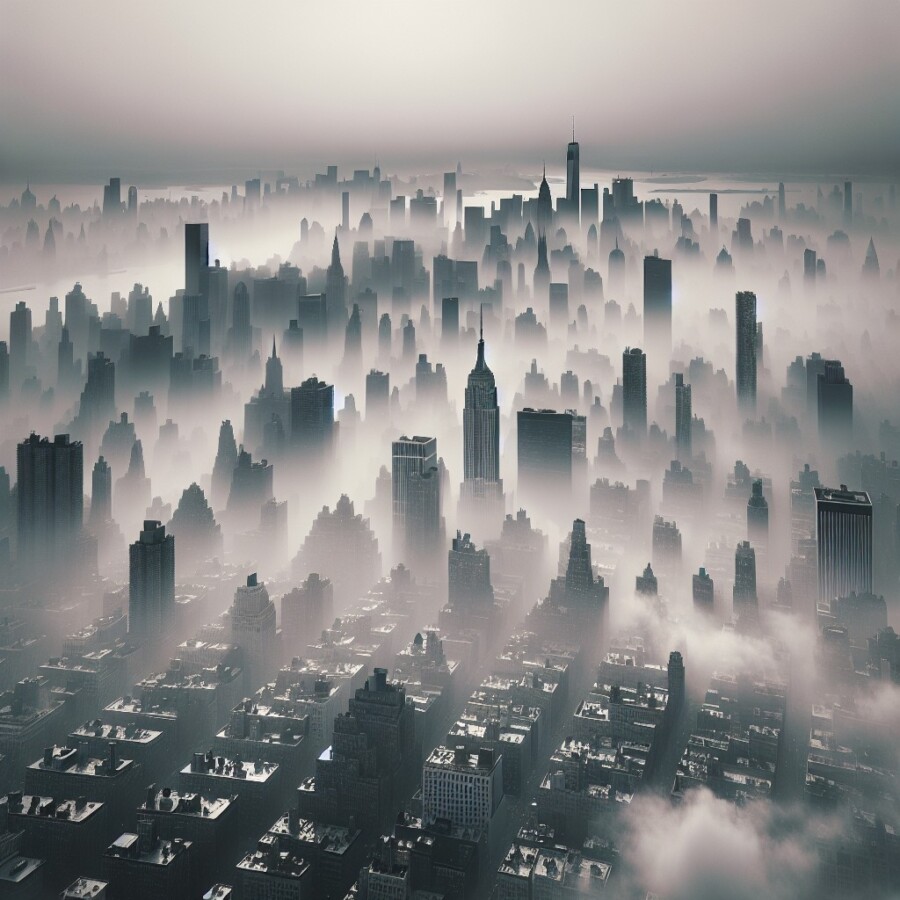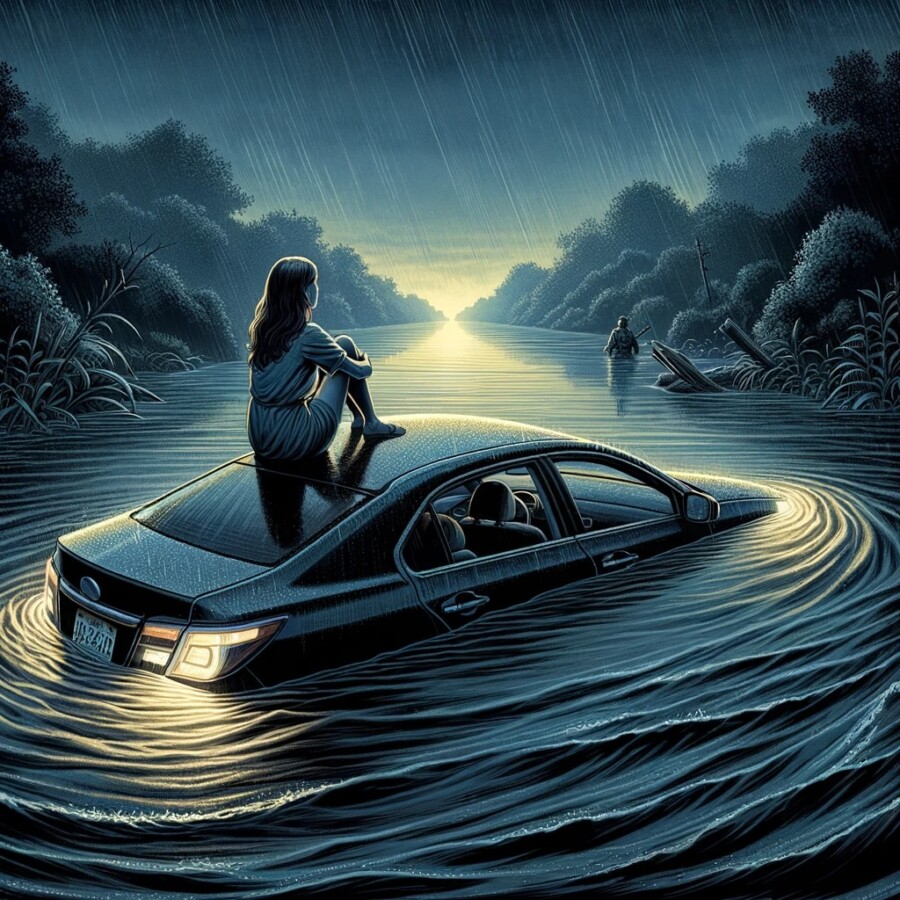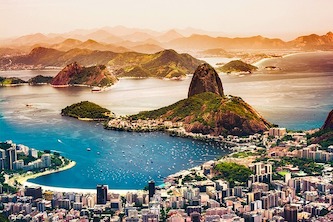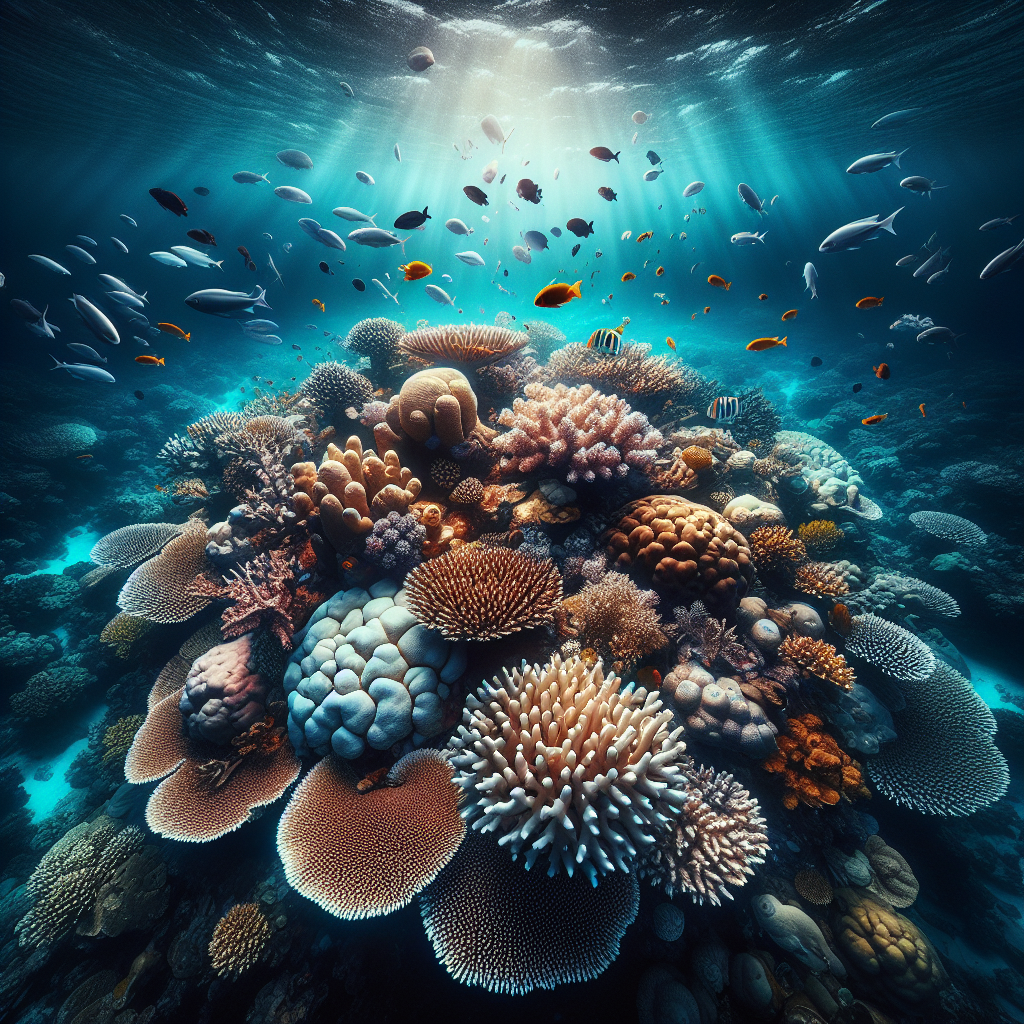On Tuesday morning, New York City was covered in really thick fog. It looked like the city was floating on clouds, which was pretty cool. This kind of fog is called ‘advection fog’ and it happens when winds blow from the east over the cool waters of Long Island Sound. The wind carries the fog into the city and southern Connecticut.
The fog was so thick that you couldn’t see the city skyline or the buildings and landmarks very well. It made everything look like a dream or something out of a movie. The fog also caused problems with transportation, like flights being delayed and ferry services being stopped.
Advection fog happens a lot in places near the coast, where cool air from the ocean meets warmer air over land. The difference in temperature makes the moisture in the air turn into fog. This kind of fog is usually really thick and makes it hard to see more than a few meters ahead.
Even though the fog caused some trouble, lots of people in New York City and tourists took the chance to take amazing pictures and videos of the city covered in mist. The fog made the city look even more beautiful and interesting. As the day went on, the fog started to go away and everything went back to normal. But people will always remember how New York City looked like it was floating on clouds.
Original news source: Dense fog transforms New York into a city on clouds (BBC)
🎧 Listen:
Slow
Normal
Fast
📖 Vocabulary:
| 1 | advection | The movement of something from one place to another, especially in the atmosphere |
| 2 | landmarks | Famous or important places that are easily recognized |
| 3 | transportation | The system or means of moving people or goods from one place to another |
| 4 | delayed | Made to happen later than planned or expected |
| 5 | ferry | A boat or ship for conveying passengers and goods, especially over a relatively short distance and as a regular service |
| 6 | coast | The part of the land near the sea |
| 7 | moisture | Tiny drops of water in the air |
| 8 | mist | A light fog or haze |
| 9 | tourists | People who are visiting a place for pleasure |
| 10 | skyline | The outline of buildings or mountains seen against the sky |
| 11 | floating | Being carried or supported by something so that it stays above the surface of water or air |
| 12 | visibility | The ability to see clearly through air |
| 13 | Connecticut | A state in the northeastern United States |
| 14 | temperature | The degree of heat present in a substance or object, especially as expressed according to a comparative scale and shown by a thermometer or perceived by touch |
| 15 | normal | The usual, typical, or expected state or condition |
Group or Classroom Activities
Warm-up Activities:
– Charades
Instructions: Divide the class into small groups. Each group will take turns acting out words or phrases related to the article, such as “fog,” “New York City,” or “advection fog.” The other groups will try to guess what they are acting out. This activity will help students practice vocabulary and nonverbal communication skills.
– News Summary
Instructions: In pairs, students will take turns summarizing the article to their partner. They should include the main ideas and key details. After both partners have had a chance to summarize, they can compare their summaries and discuss any differences. This activity will help students practice their reading comprehension and summarizing skills.
– Word Association
Instructions: Write the word “fog” on the board. In a circle, students will take turns saying a word that is associated with fog (e.g. mist, visibility, weather). Each student must say a word that has not been said before. If a student cannot think of a word within a certain time limit, they are out of the game. The last student remaining wins. This activity will help students expand their vocabulary and practice word association.
– Speed Summarizing
Instructions: Divide the class into pairs. One student will be the “speaker” and the other will be the “listener.” The speaker will have 1 minute to summarize the article to their partner. The listener should try to understand and remember as much as possible. After 1 minute, the roles switch and the listener becomes the speaker. This activity will help students practice their listening skills and ability to recall information.
– Opinion Spectrum
Instructions: Create a line on the floor with “Strongly Agree” at one end and “Strongly Disagree” at the other end. Read out statements related to the article, such as “The fog made New York City look more beautiful.” Students will stand on the line according to their opinion on each statement. Once everyone has taken a position, students can discuss their opinions and reasons with their classmates. This activity will help students practice expressing and defending their opinions.
🤔 Comprehension Questions:
1. What kind of fog covered New York City on Tuesday morning?
2. Why is this kind of fog called ‘advection fog’?
3. What problems did the fog cause with transportation?
4. Where does advection fog usually happen?
5. How does the difference in temperature create advection fog?
6. How did people in New York City and tourists take advantage of the fog?
7. What happened as the day went on?
8. How will people remember New York City during the fog?
Go to answers ⇩
🎧✍️ Listen and Fill in the Gaps:
On Tuesday morning, New York City was covered in really thick fog. It looked like the city was (1)______ on (2)______, which was pretty cool. This kind of fog is called ‘advection fog’ and it happens when winds blow from the east over the cool waters of Long (3)______ Sound. The wind carries the fog into the city and (4)______ Connecticut.
The fog was so thick that you couldn’t see the city skyline or the buildings and landmarks very well. It made everything look like a (5)______ or something out of a (6)______. The fog also caused (7)______ with transportation, like flights being delayed and ferry (8)______ being stopped.
Advection fog happens a lot in places near the coast, where cool air from the (9)______ meets warmer air over land. The (10)______ in (11)______ makes the moisture in the air turn into fog. This kind of fog is usually really (12)______ and makes it hard to see more than a few meters ahead.
Even though the fog caused some trouble, lots of people in New York City and tourists took the (13)______ to take amazing pictures and videos of the city (14)______ in mist. The fog made the city look even more beautiful and (15)______. As the day went on, the fog started to go away and everything went back to normal. But (16)______ will always remember how New York City looked like it was floating on clouds.
Go to answers ⇩
💬 Discussion Questions:
Students can ask a partner these questions, or discuss them as a group.
1. Have you ever experienced fog like the one described in the article? How did it make you feel?
2. What do you think it would be like to live in a city that is covered in fog?
3. Do you think fog can be dangerous? Why or why not?
4. How do you think the fog affected the people who were traveling in New York City that day?
5. Have you ever taken pictures or videos of a natural phenomenon? What was it and why did you want to capture it?
6. Do you enjoy looking at pictures of fog or other weather phenomena? Why or why not?
7. If you had been in New York City that day, would you have taken the opportunity to take pictures of the fog? Why or why not?
8. What are some other natural phenomena that you find interesting or beautiful?
9. How do you think the fog affected the mood of the people in New York City that day?
10. Have you ever seen a movie or read a book where fog played a significant role? What was it and how did the fog contribute to the story?
11. How do you think the fog affected the daily activities of the people in New York City?
12. Do you think fog can be a hindrance or an opportunity for creativity? Why or why not?
13. If you had the chance to experience the fog in New York City, what would you have done? Why?
14. Have you ever been in a situation where weather conditions caused transportation delays? How did you handle it?
15. What is your favorite weather condition and why?
Individual Activities
📖💭 Vocabulary Meanings:
Match each word to its meaning.
Words:
1. advection
2. landmarks
3. transportation
4. delayed
5. ferry
6. coast
7. moisture
8. mist
9. tourists
10. skyline
11. floating
12. visibility
13. Connecticut
14. temperature
15. normal
Meanings:
(A) A state in the northeastern United States
(B) The outline of buildings or mountains seen against the sky
(C) Made to happen later than planned or expected
(D) A boat or ship for conveying passengers and goods, especially over a relatively short distance and as a regular service
(E) The system or means of moving people or goods from one place to another
(F) The degree of heat present in a substance or object, especially as expressed according to a comparative scale and shown by a thermometer or perceived by touch
(G) Tiny drops of water in the air
(H) A light fog or haze
(I) The usual, typical, or expected state or condition
(J) The part of the land near the sea
(K) People who are visiting a place for pleasure
(L) The ability to see clearly through air
(M) Being carried or supported by something so that it stays above the surface of water or air
(N) The movement of something from one place to another, especially in the atmosphere
(O) Famous or important places that are easily recognized
Go to answers ⇩
🔡 Multiple Choice Questions:
1. What kind of fog covered New York City on Tuesday?
(a) Radiation fog
(b) Upslope fog
(c) Valley fog
(d) Advection fog
2. What causes advection fog?
(a) Winds blowing from the east over cool waters
(b) Warm air meeting cool air over land
(c) High humidity levels
(d) Strong sunlight
3. How did the fog affect transportation in New York City?
(a) Trains were cancelled and buses were rerouted
(b) Flights were delayed and ferry services were stopped
(c) Roads were closed and bridges were shut down
(d) Taxis were unable to navigate through the fog
4. Where does advection fog commonly occur?
(a) Mountainous regions
(b) Desert areas
(c) Inland cities
(d) Places near the coast
5. How did the fog make New York City look?
(a) Like a ghost town
(b) Like it was floating on clouds
(c) Like a scene from a horror movie
(d) Like a winter wonderland
6. What happens to the moisture in the air when advection fog occurs?
(a) It turns into fog
(b) It evaporates into the atmosphere
(c) It condenses into rain
(d) It freezes into snow
7. How did people react to the fog in New York City?
(a) They stayed indoors and avoided going outside
(b) They complained about the inconvenience
(c) They took pictures and videos of the city
(d) They celebrated the unique weather phenomenon
8. What happened to the fog as the day went on?
(a) It became even thicker and denser
(b) It moved further inland and covered more areas
(c) It started to dissipate and disappear
(d) It turned into a light drizzle of rain
Go to answers ⇩
🕵️ True or False Questions:
1. Transportation was unaffected by the fog, with flight delays and ferry services running smoothly.
2. This type of fog is usually very dense, making it challenging to see more than a few meters ahead.
3. The fog made it easy to see the city skyline and landmarks clearly, creating a movie-like atmosphere.
4. New York City was covered in thick fog on Tuesday morning, giving it a dream-like appearance.
5. As the day progressed, the fog thickened, and New York City remained hidden from view.
6. The fog, known as ‘advection fog,’ occurs when winds blow from the east over the cool waters of Long Island Sound.
7. Despite the transportation issues, few people and tourists took the opportunity to capture stunning photos and videos of the fog-covered city.
8. Advection fog commonly occurs in coastal areas, where cool ocean air meets warmer air over land.
Go to answers ⇩
📝 Write a Summary:
Write a summary of this news article in two sentences.
Check your writing now with the best free AI for English writing!
Writing Questions:
Answer the following questions. Write as much as you can for each answer.
Check your answers with our free English writing assistant!
1. What kind of fog covered New York City on Tuesday morning?
2. How does advection fog form?
3. What problems did the fog cause with transportation?
4. Why do people near the coast experience advection fog more often?
5. How did people react to the fog in New York City?
✅ Answers
🤔✅ Comprehension Question Answers:
1. What kind of fog covered New York City on Tuesday morning?
Advection fog covered New York City on Tuesday morning.
2. Why is this kind of fog called ‘advection fog’?
This kind of fog is called ‘advection fog’ because it happens when winds blow from the east over the cool waters of Long Island Sound, carrying the fog into the city and southern Connecticut.
3. What problems did the fog cause with transportation?
The fog caused problems with transportation, such as flight delays and the suspension of ferry services.
4. Where does advection fog usually happen?
Advection fog usually happens in places near the coast, where cool air from the ocean meets warmer air over land.
5. How does the difference in temperature create advection fog?
The difference in temperature causes the moisture in the air to turn into fog, creating advection fog.
6. How did people in New York City and tourists take advantage of the fog?
People in New York City and tourists took advantage of the fog by taking amazing pictures and videos of the city covered in mist.
7. What happened as the day went on?
As the day went on, the fog started to go away and everything went back to normal.
8. How will people remember New York City during the fog?
People will remember New York City during the fog as a city that looked like it was floating on clouds, making it even more beautiful and interesting.
Go back to questions ⇧
🎧✍️✅ Listen and Fill in the Gaps Answers:
(1) floating
(2) clouds
(3) Island
(4) southern
(5) dream
(6) movie
(7) problems
(8) services
(9) ocean
(10) difference
(11) temperature
(12) thick
(13) chance
(14) covered
(15) interesting
(16) people
Go back to questions ⇧
📖💭✅ Vocabulary Meanings Answers:
1. advection
Answer: (N) The movement of something from one place to another, especially in the atmosphere
2. landmarks
Answer: (O) Famous or important places that are easily recognized
3. transportation
Answer: (E) The system or means of moving people or goods from one place to another
4. delayed
Answer: (C) Made to happen later than planned or expected
5. ferry
Answer: (D) A boat or ship for conveying passengers and goods, especially over a relatively short distance and as a regular service
6. coast
Answer: (J) The part of the land near the sea
7. moisture
Answer: (G) Tiny drops of water in the air
8. mist
Answer: (H) A light fog or haze
9. tourists
Answer: (K) People who are visiting a place for pleasure
10. skyline
Answer: (B) The outline of buildings or mountains seen against the sky
11. floating
Answer: (M) Being carried or supported by something so that it stays above the surface of water or air
12. visibility
Answer: (L) The ability to see clearly through air
13. Connecticut
Answer: (A) A state in the northeastern United States
14. temperature
Answer: (F) The degree of heat present in a substance or object, especially as expressed according to a comparative scale and shown by a thermometer or perceived by touch
15. normal
Answer: (I) The usual, typical, or expected state or condition
Go back to questions ⇧
🔡✅ Multiple Choice Answers:
1. What kind of fog covered New York City on Tuesday?
Answer: (d) Advection fog
2. What causes advection fog?
Answer: (a) Winds blowing from the east over cool waters
3. How did the fog affect transportation in New York City?
Answer: (b) Flights were delayed and ferry services were stopped
4. Where does advection fog commonly occur?
Answer: (d) Places near the coast
5. How did the fog make New York City look?
Answer: (b) Like it was floating on clouds
6. What happens to the moisture in the air when advection fog occurs?
Answer: (a) It turns into fog
7. How did people react to the fog in New York City?
Answer: (c) They took pictures and videos of the city
8. What happened to the fog as the day went on?
Answer: (c) It started to dissipate and disappear
Go back to questions ⇧
🕵️✅ True or False Answers:
1. Transportation was unaffected by the fog, with flight delays and ferry services running smoothly. (Answer: False)
2. This type of fog is usually very dense, making it challenging to see more than a few meters ahead. (Answer: True)
3. The fog made it easy to see the city skyline and landmarks clearly, creating a movie-like atmosphere. (Answer: False)
4. New York City was covered in thick fog on Tuesday morning, giving it a dream-like appearance. (Answer: True)
5. As the day progressed, the fog thickened, and New York City remained hidden from view. (Answer: False)
6. The fog, known as ‘advection fog,’ occurs when winds blow from the east over the cool waters of Long Island Sound. (Answer: True)
7. Despite the transportation issues, few people and tourists took the opportunity to capture stunning photos and videos of the fog-covered city. (Answer: False)
8. Advection fog commonly occurs in coastal areas, where cool ocean air meets warmer air over land. (Answer: True)
Go back to questions ⇧














